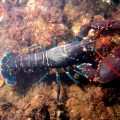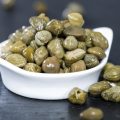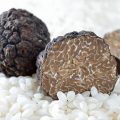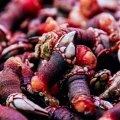Capelin, scientifically known as Mallotus villosus, is a small and slender marine fish that belongs to the smelt family, Osmeridae. This species can be found in the cold Arctic seas worldwide, but it also extends to coastal waters in the northern temperate regions. Known for its distinct features, the capelin has an olive-green topside, silvery sides, and a silvery-white belly.
While capelin is edible and has a flavor similar to herring, it is highly valued in Japan for its roe, known as masago. This delicacy is considered a high-value product and is often used in various culinary preparations. In fact, capelin roe is sometimes mixed with wasabi or green food coloring and wasabi flavor to create “wasabi caviar.”
However, despite its edible flesh, capelin is primarily sought after by fishermen for other purposes. Approximately 80% of harvested capelin is used to produce fishmeal and fish oil products, which serve various industries such as aquaculture and animal feed production. The remaining 20% is utilized to produce masago, meeting the demand for this sought-after delicacy.
Capelin plays a crucial role in the ecosystem as well. They serve as a vital part of the food web, serving as prey for larger marine species such as seabirds, whales, and other fish. Their abundance in Arctic waters also attracts predators, making them an essential link in the marine food chain.
The life cycle of capelin is intriguing. These fish spawn in large numbers during the spring and early summer, primarily along coastal areas. They lay their eggs in the sand or gravel, and the hatched larvae drift with ocean currents for several weeks. Once they reach a certain size, capelin juveniles migrate to shallow coastal waters to feed and grow. As they mature, they move to deeper offshore areas, where they join large shoals of adult capelin.
Capelin populations can fluctuate significantly due to environmental factors and the availability of food. These fluctuations can impact the overall ecosystem, as well as the fishing industry that relies on capelin as a valuable resource.
Capelin is a small but significant marine fish species found in cold Arctic seas worldwide. While its flesh is edible and resembles herring, it is primarily sought after for its roe, known as masago, which is highly valued in Japan. Capelin also plays a crucial role in the marine food web and is used extensively in the production of fishmeal and fish oil products. Understanding the importance of capelin is vital for sustainable fishing practices and maintaining a balanced ecosystem.
What Does Capelin Taste Like?
Capelin has a pleasant and agreeable flavor that is often compared to herring. The flesh of capelin is known for its delicate taste and texture, making it highly sought after in culinary circles. When consumed, capelin provides a unique flavor experience that is reminiscent of the sea.
To further describe the taste of capelin, it can be said that it has a subtle saltiness with a hint of sweetness. The flavor profile of capelin is often described as mild, making it versatile for various culinary preparations. Its taste is not overpowering but rather offers a pleasant and enjoyable eating experience.
Capelin roe, also known as masago, is a highly valued product in Japan. It is commonly used in sushi and sashimi dishes, adding a burst of flavor and texture. Masago has a slightly different taste compared to the flesh of capelin. It has a delicate and briny flavor that enhances the overall taste of the dish.
In some cases, capelin roe is mixed with wasabi or green food coloring and wasabi flavor to create “wasabi caviar”. This variation of capelin roe offers a unique taste that combines the spiciness of wasabi with the brininess of the roe. It provides a zesty and flavorful addition to various dishes.
To summarize, capelin has a pleasant and mild flavor resembling herring. Its flesh offers a delicate taste with a subtle saltiness and sweetness. Capelin roe, known as masago, has a briny flavor and is highly valued in Japanese cuisine. The combination of capelin roe with wasabi creates a flavorful and zesty experience.

Are Capelin Edible?
Capelin is edible. While it may not be as commonly consumed as other types of fish, capelin can be eaten and is considered a delicacy in some regions. It is often used in various cuisines and can be prepared in different ways, including frying, grilling, or smoking.
However, it is important to note that capelin is not primarily harvested for its edibility. Fishermen mostly target capelin for its other uses, such as creating fishmeal and fish oil products. Approximately 80% of the capelin catch is utilized for these purposes. Fishmeal is commonly used as a protein-rich ingredient in animal feed, while fish oil is extracted for its omega-3 fatty acids, which have various health benefits.
The remaining 20% of harvested capelin is used to produce a specific type of fish roe called masago. Masago is a small, orange-colored roe that is commonly used as a topping or garnish in sushi dishes. It adds a unique texture and flavor to sushi rolls and is a popular ingredient in Japanese cuisine.
While capelin is edible, it is primarily sought after by fishermen for its other uses, such as producing fishmeal, fish oil, and masago.
Are Capelin And Smelt The Same Thing?
Capelin and smelt are not the same thing, although they are both species of fish. Here are some key differences between the two:
1. Taxonomy: Capelin belongs to the family Osmeridae, while smelt refers to several species in the family Osmeridae, the family Salmonidae, and the family Osphronemidae.
2. Habitat: Capelin is primarily found in cold Arctic seas, but it can also be found in coastal waters in northern temperate regions. Smelt, on the other hand, inhabits both freshwater and saltwater environments, including rivers, lakes, and coastal areas.
3. Distribution: Capelin is widely distributed in the Arctic and subarctic regions, including the North Atlantic and North Pacific. Smelt, on the other hand, can be found in various parts of the world, including North America, Europe, and Asia.
4. Size: Capelin typically grows to about 15-25 centimeters in length, while smelt species can vary in size, ranging from a few centimeters to around 30 centimeters.
5. Physical Appearance: Capelin has a slender body with a silvery coloration and a greenish-blue back. Smelt species can have different physical characteristics, but they generally have elongated bodies with silvery scales.
6. Ecological Role: Capelin plays a significant ecological role as a forage fish, serving as an important food source for many marine predators, including whales, seals, and seabirds. Smelt also serve as prey for various predators but may have a more localized ecological impact depending on their specific habitat.
It is important to note that while capelin and smelt share some similarities as fish species, they are distinct from each other in terms of taxonomy, habitat, distribution, size, physical appearance, and ecological role.
Is Capelin A White Fish?
Capelin can be considered a white fish. The term “white fish” generally refers to fish with white flesh, and capelin fits this description. Capelin have a silvery-white color on their bellies, which is why they are often classified as a white fish. However, it is important to note that capelin also have an olive-green topside and silvery sides, so their overall appearance is a combination of colors. Nevertheless, the presence of white coloration on their bellies qualifies them as a white fish.
Conclusion
Capelin is a small and slender marine fish that is widely distributed in cold Arctic seas and can also be found in coastal waters of northern temperate regions. This species, scientifically known as Mallotus villosus, belongs to the smelt family Osmeridae.
Capelin has a distinct appearance, with an olive-green topside, silvery sides, and a silvery-white belly. It has a pointed snout and a slightly protruding bottom jaw. Despite its small size, capelin holds significant value, both as a food fish and for its role in producing other products.
The flesh of capelin is edible and is particularly prized in Japan, where it is considered a high-value product. Its flavor has been compared to herring, making it a desirable ingredient in various culinary preparations. Additionally, capelin roe, known as masago, is a sought-after delicacy that is often used in sushi and other dishes.
However, the majority of capelin harvested is not consumed directly but rather used in the production of fishmeal and fish oil products. Approximately 80% of the catch is processed for these purposes, while the remaining 20% is utilized for masago production.
Capelin is a versatile and valuable fish species that plays a significant role in both the food industry and the production of various products. Its unique characteristics and flavors make it a sought-after ingredient, particularly in Japan. As an inhabitant of cold Arctic seas, capelin contributes to the biodiversity of marine ecosystems and serves as an important resource for both humans and other marine organisms.












